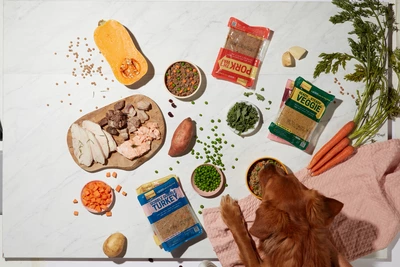From Fusspots to Foodies: How to Manage a Picky Pet
- 11 Jan 2023
- 3m read

Are you a pet parent grappling with your dog's fussy eating habits? If so, you're not alone. More and more people are sharing their experiences with fussy pups, so rest assured it’s far more common than we might think.
While a fair share of pet care professionals might dismiss the idea of a fussy dog, attributing the problem to conditioned and learned behaviour, at Butternut Box, we understand. We know that if you're here, you're probably searching for a solution to your dog’s finicky palate.
In fact, a remarkable 70% of dogs enjoying Butternut are described by their owners as either "very fussy" or "occasionally fussy".
Every day, we receive heartening Trustpilot reviews from satisfied customers who've witnessed their picky pooches become Butternut Box devotees, leaving behind their old habit of nibbling on bits of nutrient-deficient food.
We didn't just stop at observations. Recognising the importance of this issue, we joined forces with the Clinical Animal Behaviour department of the University of Edinburgh to delve into the matter. Our analysis revealed an interesting trend - poodles and poodle mix breeds seemed to display a higher tendency towards fussy eating.
Decoding Fussy Eating: A Quantitative Analysis of Dietary Preferences Among Poodles and Non-Poodle Breeds
Get ready for the science-y bit. We've carried out a comprehensive means-comparison analysis using a huge data pool of 210,466 dogs from Butternut Box's customer database.
This quantitative study focused on two main variables: Fussiness and Breed. We specifically focussed on poodle breeds, as they were the breed we were hearing most about from pet parents in regards to being fussy with food.
To measure fussiness, we employed a single-item, 4-point Likert scale. The responses ranged from 4 (eats anything) to 1 (fussy eater). The breeds of dogs were categorised into two groups: Poodles & Poodle mixes (n=46,073) and non-poodles (n=164,393).
Interestingly, our analysis revealed significant differences in food fussiness between the two groups. The poodle breeds (Mean=2.23, SD=.928) showed much higher levels of fussiness when compared to non-poodle breeds (Mean=2.54, SD=.995), with the results being statistically significant (p<.05).
In simpler terms, non-poodle breeds were much less likely to be fussy eaters, whereas poodle breeds displayed higher levels of selective eating.
What Does This Mean for Poodles, Poodle Cross Breeds, and Other Selective Eaters?
Over the past decade, poodle crossbreeds, once relatively unknown, have become household names. As the star pets of the pandemic, the Cavapoo and Cockapoo topped the charts as the most sought-after puppies. Given the increasing popularity of poodle and poodle-mix breeds, it's important to note that these dogs may exhibit higher levels of fussiness when it comes to their food.
It's time we shift the perspective in the pet care industry: Fussy eating can indeed be a breed-specific trait and not just a conditioned behaviour. This holds true for poodles, their mixed breeds, and even extends to other breeds - we’ve even got fussy Labradors on our books. Managing a fussy eater means feeding really tasty, nutritionally balanced meals that they will consistently enjoy. That's where we come in.
If you need support and are struggling with mealtimes, reach out to our Customer Love team and. our dedicated team of vet nurses who are ready to share their strategies and tips for managing fussy eaters. Let's turn those difficult mealtimes into delightful dining experiences with tail wags and happy dances.




